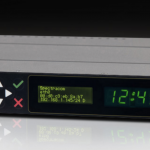 Photo courtesy of U.S. Department of Homeland Security.
Photo courtesy of U.S. Department of Homeland Security.The U.S. Department of Homeland Security (DHS) Science and Technology Directorate (S&T) is resolute in making first responders safer and more aware of jamming and its potential impact to their communications, safety and ability to execute their mission. S&T is combatting jamming threats by evaluating the threat, developing and testing mitigation technologies, working with public safety agencies to update training procedures, and raising awareness of jamming threats and characteristics.
The U.S. Department of Homeland Security (DHS) Science and Technology Directorate (S&T) is resolute in making first responders safer and more aware of jamming and its potential impact to their communications, safety and ability to execute their mission. S&T is combatting jamming threats by evaluating the threat, developing and testing mitigation technologies, working with public safety agencies to update training procedures, and raising awareness of jamming threats and characteristics.
Chronos Technology, located in Lydbrook, Gloucestershire, UK, was selected by the DHS S&T to participate in the 2017 First Responder Electronic Jamming Exercise at the Idaho National Laboratory in Idaho Falls, Idaho, USA from July 16-22. The exercise evaluated technology solutions that identify, locate and mitigate the impact of jamming of communications and positioning, navigation, and timing systems used by law enforcement and public safety organizations.
Results from the 2017 exercise will be used to develop comprehensive recommendations for federal, state and local law enforcement and public safety organizations to help them recognize, respond to, report and resolve jamming incidents. S&T’s goal is that every first responder be aware of and prepared for jamming threats, according to the DHS S&T.
The live-jamming exercise featured the first U.S. trial of Chronos’ JammerCam which triggers a photo trap as a vehicle carrying a GPS jammer passes by. JammerCam then emails the image of the vehicle to a mobile device within seconds of the event and can both pinpoint the location of the jamming signal and capture an image of its source, according to the company. The system is “always on” and continuously vigilant to the threats posed by GPS jamming, providing instant actionable intelligence for law enforcement and security professionals.
Additionally, Chronos demonstrated detection of GPS jamming with its two handheld detectors, CTL3510 and CTL3520 which also are designed to pinpoint the source of jamming/interference.
As a participant, Chronos not only had the opportunity to validate its jamming detectors in a rare open-air jamming test environment – which is illegal in the United States except under controlled and authorized conditions such as this exercise – but also tested compatibility with first responder equipment and gathered feedback directly from the first responder community.
Chronos Technology is an international authority on GNSS vulnerability detection and mitigation solutions; and resilient synchronization and timing solutions including use of GNSS, eLoran, PTP, NTP, and next generation Quantum technologies.
The DHS is charged with the primary responsibilities of protecting the United States and its territories from and responding to terrorist attacks, man-made accidents, and natural disasters.
As a first step in this program, S&T hosted the 2016 First Responder Electronic Jamming Exercise, a multi-agency operational exercise at White Sands Missile Range, in New Mexico, in July of 2016. Its purpose was to assess the impact of jamming on public safety communications systems and mission response, and identify gaps in tactics, techniques and procedures (TTPs).
The exercise also sought to better understand how jamming affects these systems and how responders can recognize and react to jamming. During last year’s exercise, DHS was able to assess the impact of different types of jammers on various radio, cellular, satellite communications and GPS systems. This threat could impact law enforcement and public safety organizations across the country.
A final analysis of the data was published in a consolidated after action report outlining results of the exercise, lessons learned, training recommendations and mitigation strategies for first responders. The 2016 exercise and report is a vital step toward shaping the DHS strategic direction for countering electronic jamming threats. To request a copy of the after action report, you can contact Jamming.Exercise@hq.dhs.gov.
To make the 2017 First Responder Electronic Jamming Exercise successful, S&T invited federal, state, local and tribal law enforcement and public safety organizations, as well as representatives from academia and industry, to participate in the event. Participating tactical and observational teams gained valuable exposure to jamming environments in a controlled and approved test environment, which will better prepare them to face real-world jamming incidents, develop solutions and help make our nation more resilient to jamming attacks.
Related reading: Canadian Army Tests NovAtel’s GPS Anti-Jam Technology





